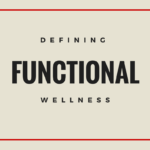Rehabilitation by Housecalls: Establishing Functional Wellness
Establishing Functional Wellness
 What is functional wellness?
What is functional wellness?
While you can’t slow down or prevent aging, you can control how well you age by proactively pursuing activities that promote healthy aging. With that in mind, your trips to the doctor don’t always mean you’re being proactive in your health because medical wellness doesn’t always reflect your functional wellness. Imagine if your doctor came into the room and lets you know that your vitals are normal and says you’re good to go home. Most would think this means that you’re in peak condition, but the reality is that your function could be declining despite being medically well. For example, while stable blood pressure is important, stable blood pressure doesn’t mean you can get up and down stairs with ease. The only way to maintain your functional ability and improve functional wellness as you age is to work with a professional who has thorough training and experience in the area of functional wellness. Those professionals are physical and occupational therapists.
The Role of Rehabilitation in Functional Wellness
Physical therapy helps a person reduce pain, regain strength, increase range of motion, improve balance and reduce the effort needed to access the community. Occupational therapy helps a person regain the ability to care for themselves, care for the people that depend on them, and to care for their home. This could be almost anything, including taking a shower, getting dressed, using the bathroom or cooking a meal.
The Rehabilitation Process
The first step in the process is to assess a patient’s current level of function, to establish a baseline of function, and then establish the goals or outcomes of the rehabilitation. A comprehensive assessment looks at more than just range of motion and strength; those things only touch the surface of the true picture of the client’s function.
Rehabilitation professionals utilize key functional outcome measures, which provide critical amounts of information on a person’s functional capabilities. After these assessments are complete, a clinician then develops the best approach for addressing any of the issues you might be seeing. If a patient has deficits in the ability to stand up from a chair, does that mean their leg muscles are weak? If they are, which ones? Or is it their standing balance that is limited? If it is poor balance, do they have a reduction in blood pressure upon standing that creates dizziness or do they lack postural control? The “why” behind the deficits determines the most appropriate interventions and is the cornerstone of how a personalized plan of care is developed.
Rehabilitation by Housecalls: The FOX Rehabilitation Model
Patients often move through the medical system and are determined medically well, which is appropriate by their standards. But when it comes to functional wellness, housecalls fills a void that hospitals and doctor’s offices cannot. Rehabilitative services tend to focus on not only reactive strategies for functional wellness (i.e. post-surgery rehab) but also proactive methods to ensure you’re at your peak.
While homecare services allow for personalized delivery of physical therapy, occupational therapy, speech language pathology and nursing care in your own home, outpatient therapy allows for physical therapy, occupational therapy and speech language pathology services but do not offer the services of a nurse. Outpatient services focus on higher-level functional goals and often exceed the goals sets by homecare services that focus on medical stability, while focusing on overcoming or avoiding becoming homebound, so you can maintain independence.
Some practices, including FOX Rehab, have chosen to provide outpatient services as a house call. Under this model, the services typically delivered in a brick and mortar clinic setting are delivered in the home. This way, the clinician can evaluate a client’s ability to transfer to standing from their couch or climbing the stairs to their bedroom, both of which a traditional clinic setting does not allow. Also, many older adults find transportation to and from the clinic multiple times a week for therapy difficult. Housecalls provide a number of benefits that might be absent in a visit to the clinic.
One of the most apparent benefits of utilizing house calls is that it gives the clinician a real-life look into the patient’s day-to-day challenges they realistically face. It isn’t just based on what the patient is telling the clinician; he or she can actually see it and assess from there. Additionally, house calls add a layer of comfort they might be missing in clinic, which can allow for less inhibitions when it comes to trying new therapy programs. When a clinician, comes to your home they are also offering an increased level of personalized care that isn’t always available in high-volume settings. For example, the length of hospital stays has decreased by three days since 1990, an alarming decline considering the need to properly assess function (Kleinpell, Fletcher and Jennigs: Patient Safety and Quality: An Evidence-Based Handbook for Nurses).
Physical therapy works on promoting overall function, like helping you get up the stairs in your home, while occupational therapy focuses on the finer details of daily functioning, like getting in and out of your recliner. Occupational therapists are the trouble shooters of the rehabilitation process; they make the impossible possible through the use of adaptive equipment, home modifications and functional strengthening, which highlights why housecalls are so vital in the occupational therapy process.
When occupational therapists complete evaluations, they ask the questions, “What do you want to be able to do? What is important to you?” By asking these questions, the occupational therapist begins to identify the clients goals, both short-term and long-term, and is able to make a plan to get there. For example, if the patient wants to be less of a burden to his or her kids or grandkids, the occupational therapist can work with the patient on rearranging the kitchen, so that everything they need is reachable and available without the help of another person.
For patients who fear slipping and falling in the shower, they might sponge until their strength and balance are restored or have the confidence to take a standing shower. An occupational therapist can evaluate the bathroom set up and possibly recommend a grab or non-slip mat in the shower.
Summary of Functional Wellness
If functional wellness wasn’t at the forefront of your health considerations, you should consider evaluating this the same way you evaluate your medical wellness. Functional decline is inevitable, but you can still take a proactive approach in addressing some of the common issues aging adults face. With services, like physical and occupational therapy, you can keep doing what you love no matter your age.
SOURCES:
Chapter 11 Reducing Functional Decline in Hospitalized Elderly, Ruth M. Kleinpell; Kathy Fletcher; Bonnie M. Jennings. https://www.ncbi.nlm.nih.gov/books/NBK2629/
Category: Articles



































